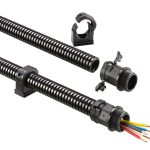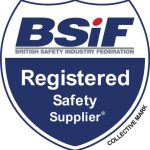 Gordon Low, marketing segment manager at COOPER Crouse-Hinds, discusses how factories can reduce the risk of dust explosions occurring in the workplace and the latest standards relating to explosion-proof electrical equipment installed in these areas
Gordon Low, marketing segment manager at COOPER Crouse-Hinds, discusses how factories can reduce the risk of dust explosions occurring in the workplace and the latest standards relating to explosion-proof electrical equipment installed in these areas
Many people may believe that the risk of a dust explosion occurring in a factory is pretty unlikely. However, because a dust explosion only requires three things (air, combustible dust and a source of ignition such as an electrical spark or hot surface), the likelihood of one occurring is not such a remote possibility.
Indeed, combustible dusts are present in many manufacturing environments, meaning many companies are potentially at risk. Wood shavings, carbon dust, flour, grain, custard powder, sugar, coffee, tea, animal feed, plastic and aluminium dust are just some examples of highly combustible dusts. The problem is when these combustible dusts are left to gather on hot surfaces in a workplace, such as on an overheated electric motor or fan. This can cause smouldering fires to occur, or can cause an explosion when the dust is kicked up, for example, by a person opening a nearby window.
Dust explosions can have catastrophic consequences because the initial shock wave resulting from the explosion kicks up more dust, which triggers a chain reaction through the plant, often resulting in mass destruction of equipment and buildings, as well as causing possible death or injury to employees.
 Be aware of the risks
Be aware of the risks
All electrical equipment installed in these areas are potentially sources of ignition and as such need to be adequately protected and designed to operate under these conditions. This includes mixers, filling hoppers, conveyor systems, mills, silos, dust extraction plant, kilns and drying systems. Directors, company owners, plant managers and maintenance engineers, in fact anyone who is responsible for the health and safety of employees or for sourcing electrical equipment for hazardous areas, needs to be fully aware of the risks of dust explosions, the European directives and standards relating to electrical equipment installed in hazardous areas, as well as the measures that can be taken to eliminate the risk of dust explosions occurring. Therefore, the European Directive for hazardous equipment 94/9/EC pointed out that this was valid in the same way for dust explosion protected equipment as well as for gas hazardous areas.
Owners of new equipment are governed by the compulsory European Directive 1999/92/EC, implemented in the UK as the ‘Dangerous Substances and Explosive Atmospheres Regulations 2002’ (DSEAR). From 2006, this directive also includes ‘old’ as well as ‘new’ equipment. In summary, owners are required to identify the risks of explosion, implement explosion protection measures such as avoiding sources of ignition (secondary explosion protection), define zones in areas at risk from dust explosions, create an explosion protection document, use suitable production equipment and create a test plan.
Changes to the standards
The standards for electrical equipment in areas at risk from dust explosions have seen a few changes in the last few years. EN 61241-0 came into effect from 1st July 2007 and came into force on the 1st October 2008. This stricter standard superceded the old standard EN 50 281.
On 16th April 2010, the new version of the standard EN 60079-0:2009 was first published in the Official Journal and came into effect. In this standard, the requirement for explosive dust atmospheres now includes significant changes with respect to the previous edition. These are listed below:
• Requirements for explosive dust atmospheres transferred from IEC 61241-0.
• Dust groups defined as Group IIIA, IIIB and IIIC.
• Equipment protection levels (EPL) introduced.
This new standard will supercede the old existing standard EN 60241-0 on 1st June 2012. Within this new series of standards, one of the main protection types for production equipment at risk from dust explosions in accordance with ATEX Directive 94/9/EC is the protection by enclosures type ‘tD’ as given in IEC 61241-1. This protection type is where the electrical production equipment is equipped with an enclosure to prevent the penetration of dust and where measures to limit the surface temperature have been implemented.
There are also a number of changes to the current and future standards, which you should be aware of. There are increased requirements, from the old 50281 series to the 61241 series and now to the 60079 series such as impact energy – high demand on impact energy as in Zone 1, electrostatics – electrostatic conductance of the enclosure, and ageing resistance – high demand on the ageing resistance of the plastic enclosure associated with an ingress protection test after ageing. Customers need to be aware of these changes when sourcing or upgrading electrical equipment for hazardous dust areas, so that they can purchase equipment that fully complies with the new requirements.
 Zones and groups
Zones and groups
Hazardous areas for explosive dust atmospheres are classified into three Zones – 20, 21 and 22. Zone 20 is an area in which an explosive atmosphere in the form of a cloud of combustible dust in the air is present continuously, or for long periods or frequently.
Zone 21 is an area in which an explosive atmosphere in the form of a cloud of combustible dust in the air is likely to occur in normal operation occasionally.
Zone 22 is an area in which an explosive atmosphere in the form of a cloud made up of combustible dust in the air is not likely to occur in normal operation but, if it does occur, will persist for a short period only.
For equipment to be used in explosive dust atmospheres, the sub-grouping system as known from the sub-grouping system for explosive gas atmospheres is now also implemented for explosive dust atmospheres. Electrical equipment of Group III is sub-divided according to the nature of the explosive dust atmosphere for which it is intended.
Group III sub-divisions:
• IIIA – combustible flyings.
• IIIB – non-conductive dust.
• IIIC – conductive dust.
The equipment protection level (EPL), which is the level of protection assigned to equipment based on its likelihood of becoming a source of ignition, and distinguishing the differences between explosive gas atmospheres, explosive dust atmospheres, and the explosive atmospheres in mines susceptible to firedamp, is now also implemented for explosive gas and for explosive dust atmospheres (details can be found in the standard EN 60079-0).
When can dust explode?
As previously mentioned, a dust explosion requires three ingredients – air, combustible dust and a source of ignition. Combustible dust-air mixtures have different ignition temperatures. The surface temperature of the equipment in areas where there is a risk of dust explosions is allowed to reach two thirds of the minimum ignition temperature of the surrounding dust-air mixture. With a 5mm thick layer of dust, this surface temperature must be at least 75°K below the minimum ignition temperature of the dust (glow temperature).
It is therefore the equipment owner’s responsibility to ensure that the cleaning and maintenance intervals of installed equipment with a dust explosion risk are scheduled so that no dust layers thicker than 5mm are allowed to form. At higher dust deposits, the minimum ignition (glow) temperature of the dust is reduced significantly.
The goal of the current European directives is to protect operating plants from dust explosions and to prevent damage or personal injury. The explosion protection measures are divided into ‘Owner’ and ‘Manufacturer’ Directives. Again, the objective is to implement all necessary measures to ensure that explosion protected products can only be operated if they do not pose any danger to health and safety and provided that they are correctly assembled, installed, maintained and used for their intended purpose.




